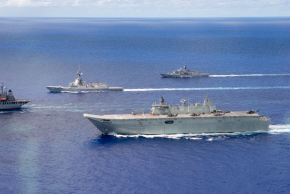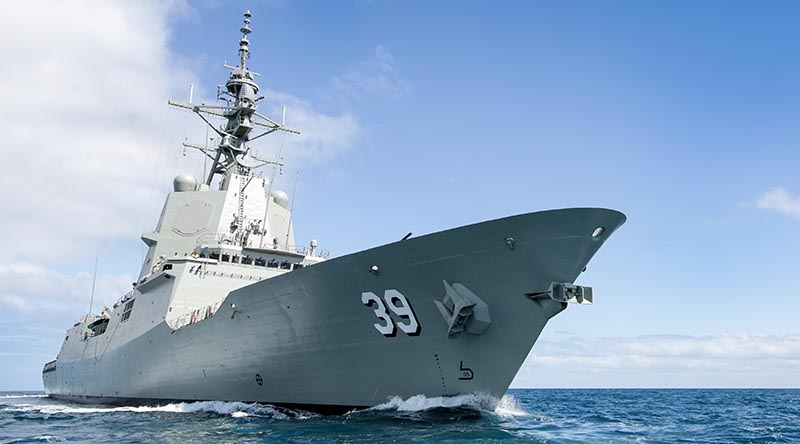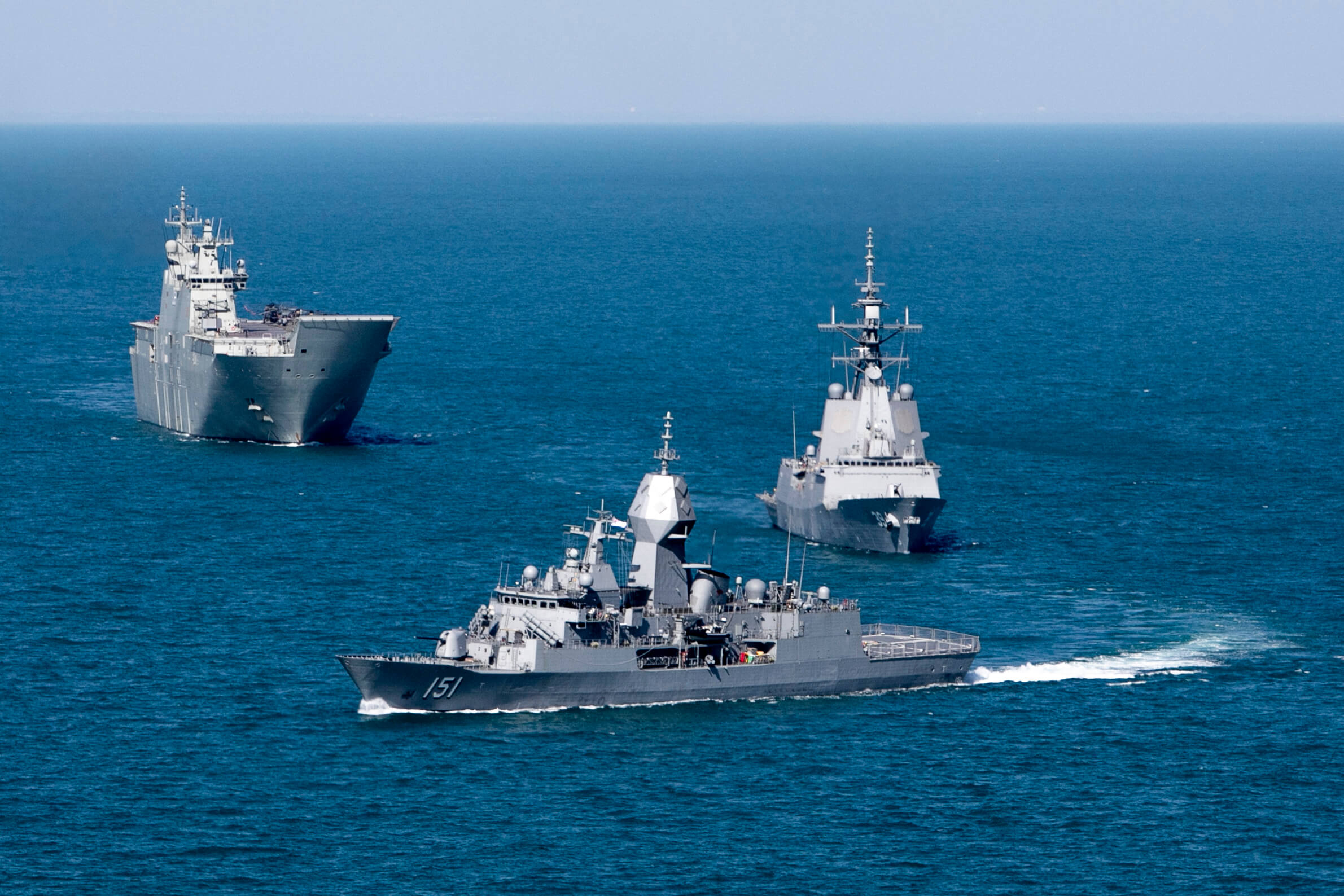All IMO..
How survivable is a ship that can't see, can't communicate and can't coordinate a response. The future is networked combatants that share data, share information, even coordinate the frequency and direction of their sensors to gather a full map with the least and most distributed, stealthy and un-jamable way possible. Even in the ASW space this includes assets like MH60R's and aegis ships sharing data over Hawklink, which can link with data from P8's and other assets to form a complete picture above and below the surface. Aegis isn't going away, it is becoming everything, a common library of computer protocols for Army, Airforce and Navy to share data and tactical information across all battlespaces for all equipment.
What do we need that is feasible in the very short term to project a strong offensive capability against the logical opponent in our region? Is NSM the answer or do we need longer-ranged weapons like surface-launched LRASM, and how does this affect the size of vessels required
NSM is still fairly short ranged. It is however more modern, more effective. It is effectively silent death, rather than Harpoon beaming with multiple radars on a 1970's airframe. NSM will also allow for an increase in load out, We can put 12 NSM where we have 8 harpoons in many cases, or put 8 NSM and use the weight savings for other systems.
LRASM is longer ranged, smart, stealthy and a heavy hitter. TLAM is even longer ranged, but on an older airframe, but gives tremendous reach. But these will consume VLS very quickly on the Australian fleet given how few cells we have and how modern ships are not one shot one kill propositions. Currently at anyone time, we can only basically assume 1 Hobart is ready and able to deploy. During the Aegis updates, it will drop to less than 1. Which is why I support 3 new build Hobart's. This would give 6 broadly similar in capability (if different in design and specs) ships, that could carry 48 VLS. Having 6 ships means that we could have 2-3 ships deployed most of the time, so going from 48 VLS to 96-144, and a possibly surging beyond even that. This is why Spain built 5 and not 3. This is why the UK built 6 type 45's. We could have by 2029, if we chose to, have the same air warfare capability as the UK has with its fleet of 6 Type 45's with 6 Hobarts (3xHobart 1 and 3xHobart 2). Unlike the UK, ours would be aegis, with CEC, SM2, SM6, potentially SM-3, TLAM (UK can only fire TLAM from their subs), and quad packing the modern ESSM II.
We currently have no hunters, so only the Hobarts can handle these weapons, although perhaps TLAM on Collins can be done with LOTE and while Collins isn't going to carry a huge number, they won't know exactly where it is, so 6 TLAM popping up from basically anywhere is a huge wild card. TLAM is long enough ranged that firing it from a diesel sub means that it could still be 1000nm away from its target, and quite likely beyond detection of the launch and beyond chasing it down. Keeping diesel subs relevant for a while yet. Sub launched NSM might be even better in this regard given its stealthier and smarter capabilities, although trading range for that.
But in modern western Navies, typically surface ships are not the main anti-shipping system. That is aircraft. Currently we have very few aircraft that can fire LRASM.. AFAIK Only 24 Superhornets... P8's perhaps later this year or early 2024, F-35 will have to wait until blk IV. We have also limited capability to sustain aircraft over 1000nm from our airbases.
The Hunters (and the F-35) are fantastic weapons. But their age has not yet really arrived. Hunters will be post 2030. Blk IV F-35 is probably similar 2027-2030. They are the future. With the F-35 we are hopefully going to receive the full delivery this year, and they can perform some missions, they just aren't really in their final form just yet. Technical refresh 3 has just flown, so its very close. These will arrive, we just need to wait for that.
So until then - IMO it basically a single Hobart/FFG (IndoPacific Endev before we had all the Hobarts we had to use a FFG) on deployment at anyone time with maybe a Collins lurking if within region. It has historically protected a LHD and had an Anzac tagging along.
 This is about all we can manage on a good day. Image from US and Australian Joint Task Force Exercise in Guam: July 2020 - Second Line of Defense - But the Image is from the ADF uncredited.
This is about all we can manage on a good day. Image from US and Australian Joint Task Force Exercise in Guam: July 2020 - Second Line of Defense - But the Image is from the ADF uncredited.
Share the post "Fourth three-ship Indo-Pacific deployment for 2022 departs" FacebookLinkedInPinterestTwitterShare…Email Three Royal Australian Navy ships have commenced a regional
www.contactairlandandsea.com
Commodore Michael Harris, Commodore Flotillas, explains the Royal Australian Navy's task group command structure to Dr Lee Willett.

www.armadainternational.com
Going into 2025 we will lose Hobart capability and our Collins capability will be capability gapped as the fleet gets smaller while we pull ships and boats out to upgrade them.
Is a corvette likely to give us the strike power required to make it worth the effort?
IMO- No. No corvette is big enough to carry the sensors, weapons and sensors and have the range we need. We could build a good corvette, but a corvette won't be regionally useful, and won't change the equation against China. We aren't trying to deter a middle power, but a peer of the US.
The US is also looking at trying to build up their fleet as fast as they can. Their solution is the Constellation class, a 57mm gun, 32vls, 16xNSM, aegis compatible subset combat system (aegis10), firing SM-2, SM-6, ESSM, Spy 6 radar etc. They tried the corvette thing, and wasted a lot of time and money. They Europeans do the corvette thing better, but even there in a protected Mediterranean sea, it has limitations.
A large ship like a Burke would kill the RAN and reduce the number of VLS at sea, because the crewing requirements.
You would have 1 burke for 2 Hobart's (96 Hobart's cells, 48 available at a time, for 96 Burke cells available half the time). You would have 1 burke for 3 Anzacs or 3 Hunters (96 burke cells for 3x32=96 hunter cells, hunters available 3 times as much). When the ship would be unavailable during refit, upgrades etc we would loose most of the RAN. They are too man power intensive, but also maintainer intensive, fuel intensive, missile intensive. Like by a factor of 3-6 times compared to something like a Hunter. Burke Radars are located lower than a Hobarts, they have shorter radar horizons than a Hobart or a Type 45 despite being a bigger ship. There are dimensions beyond VLS count that are important, particularly for a middle power navy.



